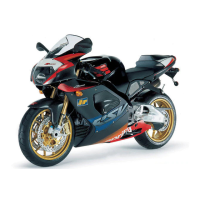
Do you have a question about the APRILIA RSV 1000 R and is the answer not in the manual?
| Engine Type | V-twin, 4-stroke |
|---|---|
| Displacement | 998 cc |
| Compression Ratio | 11.8:1 |
| Fuel System | Electronic fuel injection |
| Transmission | 6-speed |
| Dry Weight | 189 kg |
| Cooling System | Liquid-cooled |
| Ignition | Electronic |
| Front Brakes | Dual 320 mm discs |
| Rear Brakes | 220mm disc |
| Front Tire | 120/70 ZR17 |
| Rear Tire | 190/50 ZR17 |
| Power | 143 hp (106.6 kW) @ 9, 750 rpm |
| Frame | Aluminum twin-spar |
| Front Suspension | Upside-down fork, fully adjustable |
Introduction to the manual and its purpose, including important safety notes.
Information and warnings regarding carbon monoxide exposure from the engine.
Identification and caution regarding hot parts of the engine and exhaust system.
Explanation of various warning lights on the instrument panel and their meaning.
Description of the function and operation of control elements on the vehicle.
Information about the coolant, its properties, and handling precautions.
Advice on handling and disposal of used engine and gearbox oil.
Information on brake and clutch fluid, including precautions and handling.
Safety warnings and handling instructions for battery gases and electrolyte.
Instructions and warnings related to the vehicle's stand.
Procedure for reporting safety-affecting defects and necessary information.
Precautions to take before disassembling vehicle components.
Guidelines and precautions for safely removing vehicle parts.
Instructions and recommendations for reassembling vehicle components correctly.
Information and precautions regarding the disconnection and connection of electric parts.
Guidelines and warnings for correctly tightening various components.
Identification and function of dashboard controls and indicators.
Description of the analog and digital instrument panels and their indicators.
Identification and description of the various lights and control lamps.
Instructions for setting and using the chronometer function.
Procedure for starting the timekeeping function of the chronometer.
Steps to activate the chronometer function and its display.
Instructions on how to reset the chronometer memory.
Description of the function of the control buttons on the instrument panel.
Details on advanced functions like metric conversion and data display.
Instructions for switching between metric and imperial units.
How to view current, max, and average speeds and battery voltage.
Interpreting the battery voltage display for working status.
How to adjust the intensity of the instrument panel backlight.
Instructions for viewing odometer and trip meter readings.
How to view the coolant temperature and interpret its display.
Instructions for setting the digital clock on the instrument panel.
Procedure for setting the hours on the digital clock.
Procedure for setting the minutes on the digital clock.
Information on the diagnostic system and error indications.
Explanation of the engine oil pressure warning light.
How to adjust the engine overrevving threshold.
Description and operation of the ignition switch.
Instructions on how to lock the steering wheel.
Step-by-step guide to locking the vehicle's steering.
Description and operation of the horn button.
How to operate the direction indicator switches.
Instructions for operating the high and low beam light selector.
How to use the passing button for high-beam flash.
Description and operation of the engine start-up button.
How to use the engine stop switch for safety.
Details on vehicle operation and the immobilizer system.
Instructions for opening the rider and passenger saddles.
How to access and secure the glove/tool kit compartment.
Information on locating and identifying chassis and engine numbers.
Location and identification of the vehicle's chassis number.
Details on using the luggage anchor points for securing cargo.
Pre-ride checks and safety procedures before operating the vehicle.
Essential checks to perform before riding the vehicle.
Instructions and warnings for refuelling the vehicle's fuel tank.
Guide to adjusting the rear shock absorbers for ride comfort and performance.
Instructions for adjusting the front fork settings.
How to adjust the front brake lever grip.
Instructions for adjusting the rear brake pedal.
How to adjust the clutch lever for optimal engagement.
Guidelines for the engine run-in period to ensure proper performance.
Step-by-step instructions for starting the vehicle's engine safely.
Procedures and tips for safely moving off and riding the vehicle.
Instructions on how to start the engine and begin riding.
Instructions on how to safely stop the vehicle's engine.
Procedure for stopping the engine when the scooter is stationary.
Information and warnings regarding the catalytic silencer.
Instructions for using and securing the vehicle on its stand.
Tips and precautions to prevent vehicle theft.
Fundamental safety guidelines for operating the vehicle.
Instructions and safety precautions for mounting the vehicle.
Instructions and safety precautions for dismounting the vehicle.
Procedure for checking the engine oil level.
Instructions on how to add engine oil to the correct level.
List of recommended oils, greases, and fluids for maintenance.
Guide for changing the engine oil and filter.
Instructions for replacing the engine oil filter.
Procedure for removing, cleaning, and replacing spark plugs.
Steps required to remove the spark plug.
Instructions for cleaning spark plugs.
Guide for removing the air filter element.
Instructions for cleaning and replacing the air filter.
Procedure for partial cleaning of the air filter.
Instructions for replacing the air filter element.
Procedure for checking and topping up the coolant level.
Steps for checking and topping up the coolant.
Procedure for checking the brake fluid level.
Instructions for topping up the brake fluid reservoir.
Procedure for checking the clutch fluid level.
Instructions for topping up the clutch fluid.
Guidelines for installing and connecting a new battery.
Procedure for checking the battery's electrolyte level.
Instructions for safely charging the vehicle's battery.
Recommendations for storing the vehicle during extended periods of inactivity.
Information on fuse locations, types, and replacement procedures.
Details on the distribution and function of secondary fuses.
Details on the distribution and function of main fuses.
Instructions for replacing various vehicle lamps.
Procedure for replacing high and low beam headlight bulbs.
Instructions for adjusting the headlight beam alignment.
Steps for adjusting the vertical position of the headlight beam.
Steps for adjusting the horizontal position of the headlight beam.
Instructions for replacing front turn signal bulbs.
Information on the rear optical unit and LED replacements.
Instructions for replacing rear turn signal bulbs.
Procedure for replacing the number plate light bulb.
Information regarding the LED brake light.
Instructions for checking and maintaining the front and rear disc brakes.
Recommendations for vehicle preparation and storage during inactivity.
Guidelines for cleaning the vehicle under various conditions.
Instructions and precautions for transporting the vehicle.
Procedure for checking the play in various vehicle components.
Instructions for adjusting chain and sprocket settings.
Guide for inspecting wear on the chain, front, and rear sprockets.
Instructions for lubricating and cleaning the drive chain.
List and description of the tools included in the kit.
Overview of scheduled maintenance intervals and tasks.
Checks to be performed before every engine start.
Maintenance tasks required before each ride and at 2000 km intervals.
Maintenance tasks to perform after the initial run-in period.
Maintenance tasks required at 1000 km intervals.
Specific maintenance for racing use at 5000 km intervals.
Maintenance tasks required at 20,000 km or 24-month intervals.
Maintenance tasks required every 24 months.
List of recommended products for maintenance and servicing.
Index of special accessories and their identification.
Instructions for removing the rider's saddle.
Procedure and safety precautions for lifting the fuel tank.
Instructions for removing the side fairings.
Instructions for removing the lower fairing panels.
Instructions for removing the upper front fairing.
Information on the importance of official service and maintenance.
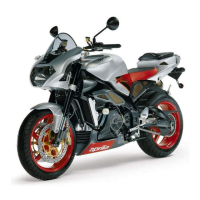
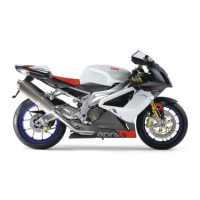
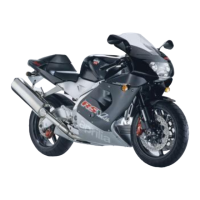
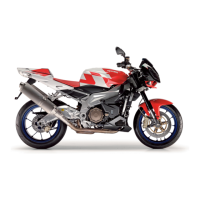
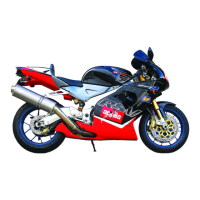
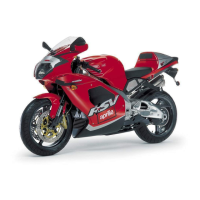

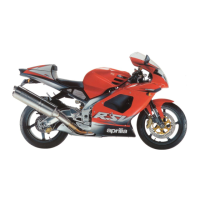
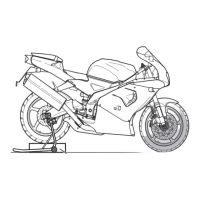
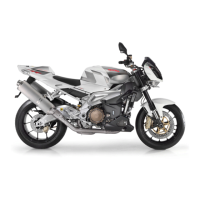
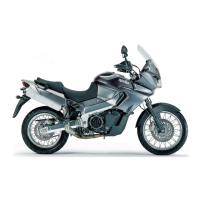
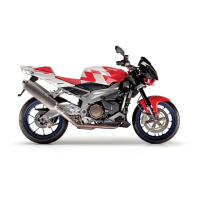
